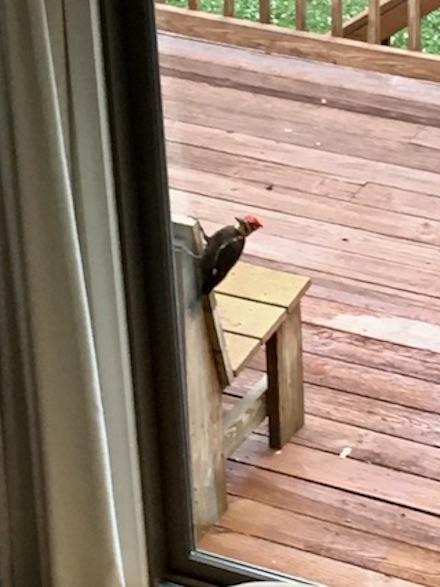Encounters with a pileated woodpecker, for family and friends, continued.

The tale from Christmas, 2021:
The pileated woodpecker is a large bird of striking appearance, a proud native of North America, and possessing the technology to excavate dead trees. Our Christmas 2021 letter related how one local specimen (photo above) became obsessed with our house. We would be awakened by jackhammer-like sounds. Nothing we tried discouraged him in the slightest. He badly tore up two corners of the redwood siding on our house and other boards. He would stand in front of our sliding glass doors, or hang on a window sill, and look in and pound on the glass, like he had something to tell us. We had some things to tell him, but he would never hang around long enough to hear them. We wrote in our letter that we did not know how the story would end.
The tale, continued:
In 2021 we were also negotiating with a contractor for some standard maintenance and exterior painting on our house. In April 2022, the contractor sent carpenters and painters to do the maintenance, repair the woodpecker damage, and restore the exterior to tip-top shape. They did a great job, and we were very pleased. Unknown to us at the time, the painters did us a huge favor. Professional painters spend as much time preparing the surface as painting. Part of their “prepping” was to fill all of the old carpenter bee holes in the redwood in a two-step process. We had never heard of such a thing. The first step was to inject a filler into the holes to a depth of 3-4 inches into the tunnels made by the bees, the second was to cosmetically cover the holes with a different filler. The first step would obviously be bad for any larvae left in the tunnels by the bees, and this proved to be crucial.
When the workmen finished, it was late April 2022, and Spring, normally a glorious time of year in central Virginia. Two threats to our tranquility loomed. One was the return of the woodpecker, the other that it was also time for new carpenter bees to arrive and do their thing, which is to drill holes and pack them with larvae.
The woodpecker indeed returned as soon as the workmen left, but his behavior was different. He did not like what he found. To our surprise, he lost interest in the house and stopped coming. From his perspective, the neighborhood had gone downhill. Why? We surmise that he only ever had two interests in the house. One was housing, but spring is the wrong time of year for nesting. The other was food -- the carpenter bee larvae, which he could detect. But thanks to the painters, the larvae in the old tunnels were destroyed by the first filler.
Ha, you might be thinking, what about new carpenter bee holes and new larvae? The cycle will repeat. However, just then, Virginia searched online for carpenter bee traps. She chose a brand, Best Bee Brothers, and ordered six traps. We strapped three onto the redwood on the front side of the house and three on the back side. Now, everybody knows that insect traps don’t work. They just attract the pests you are trying to get rid of. We also believed this, but we were wrong. They did work. The traps have no pheromone to attract the critters, just a hole in plain wood. It turns out that carpenter bees are lazy and will buzz around endlessly to find another critter’s hole before making their own. In May, dozens and dozens buzzed furiously around our house, as they have been doing for years. However, this year one by one they fell into the traps. We soon removed nearly a hundred carcasses from the traps, and after perhaps 6 weeks we saw no more carpenter bees, and for the rest of the summer hardly any at all. We did not find a single new carpenter bee hole in the summer of 2022.
Is this the end of the story? We dare to think, yes! Our fellow returned once mid-summer. He stood in front of the glass door, rapped on the glass, and queried, you guys still here? We think it was a social call.
